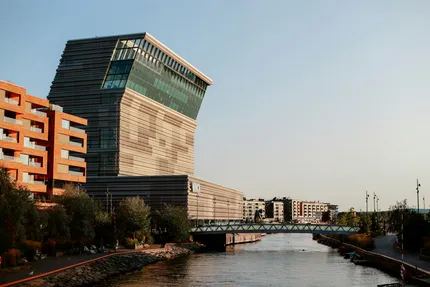CityTouring
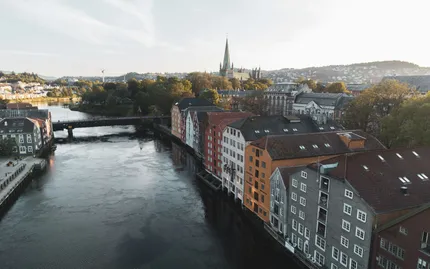
City trip to Trondheim
NorwayTrondheim pairs deep medieval history with a relaxed, student-driven energy on the shores of the broad Trondheimsfjord. Norway’s former capital centers on Nidaros Cathedral, the country’s national sanctuary and the end point of the St. Olav pilgrimage routes; its stonework, stained glass and adjacent Archbishop’s Palace Museum anchor the old town. Across the Nidelva river, Bakklandet’s wooden townhouses, cobbled lanes and cafés invite unhurried wandering, linked by the photogenic Gamle Bybro.
The city’s waterfront has been renewed at Solsiden, where dockside restaurants face colorful warehouse facades. Museums are strong for a city this size: Rockheim (pop music), Ringve (music history with gardens) and the Sverresborg Trøndelag Folk Museum. For views, climb Kristiansten Fortress or ride to the Tyholttårnet tower. Nature is woven in: the Gråkallbanen tram runs from the center to trailheads in Bymarka’s forests and lakes, and short boat trips reach Munkholmen island. Dining ranges from casual seafood to Michelin-starred rooms at Credo, Fagn and Speilsalen. Compact, walkable streets, reliable buses and a welcoming café culture make short stays easy.
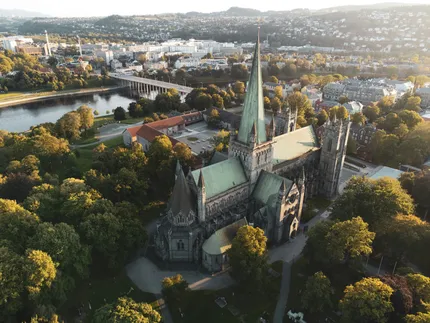
Nidaros Cathedral (Nidarosdomen)
Norway’s national sanctuary and the world’s northernmost medieval cathedral, Nidarosdomen is a masterpiece of Gothic architecture. Admire the sculpted West Front, soaring nave, and stained glass. Explore the crypt and climb the tower in season for city views. The adjoining Archbishop’s Palace museums display royal regalia and archaeological finds nearby.
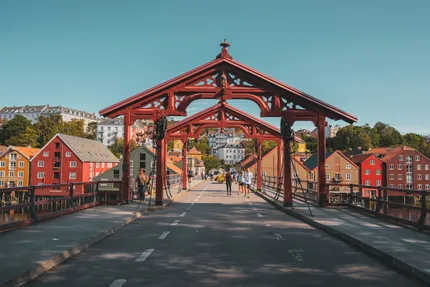
Bakklandet and Old Town Bridge (Gamle Bybro)
Stroll Trondheim’s most photogenic district of colorful wooden houses and cafes along the Nidelva. Cross the 19th‑century Gamle Bybro, known as the Portal of Happiness, for classic riverfront views of warehouse facades. Wander cobbled lanes, browse small shops, and try the Trampe bicycle lift, a quirky local transport novelty too.
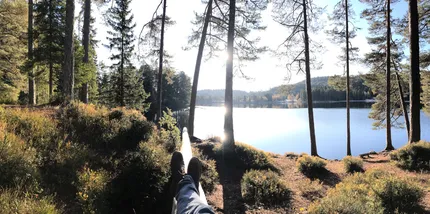
Bymarka Nature Reserve
West of the city, Bymarka offers lakes, forests, and heath with well‑marked trails for hiking, trail running, and cross‑country skiing. Take the tram or bus to Lian or Skistua trailheads. In summer, swim or fish; in winter, groomed tracks and cozy cabins serving waffles and cocoa provide classic Norwegian outdoors.
Trondheim suits travelers who like compact, culture-rich city breaks balanced with easy nature access. History-minded visitors can tour Nidaros Cathedral, see the crown regalia and archaeological finds at the Archbishop’s Palace, walk the ramparts of Kristiansten Fortress, and spend an afternoon among farm buildings and folk traditions at Sverresborg. Urban explorers and photographers will enjoy sunrise or evening light on the timber warehouses along the Nidelva, viewpoints from the fortress and Tyholttårnet, and the café-lined streets of Bakklandet; the quirky bicycle lift here is a fun one-off. Families do well with interactive museums such as Rockheim and the NTNU University Museum, the large indoor pools at Pirbadet, and an easy ride on the Gråkallbanen tram to Lian for stroller-friendly paths and playgrounds.
Active travelers can fill a weekend with Bymarka hikes, winter cross-country loops, running or cycling the Ladestien coastal path, and short fjord cruises or boats to Munkholmen when weather allows. Food-focused visitors have plenty of range, from casual seafood at Ravnkloa and along the harbor to tasting menus at Credo, Fagn, or Speilsalen, plus taprooms at Austmann and E.C. Dahls.
With frequent airport trains, walkable distances, and reliable buses, you can comfortably see the essentials in 48–72 hours without a car. Evenings are relaxed rather than raucous, with cozy pubs, craft beer bars, and live music around the center and Solsiden. English is widely spoken, and contactless payment is standard, which keeps logistics simple for a short stay.
Three top reasons for a city trip to Trondheim
- Stand in awe at Nidaros Cathedral, Norway's national shrine, exploring its Gothic nave, rose window, and crypts, then visit the Archbishop's Palace to see the Norwegian crown regalia and exhibits.
- Wander Bakklandet's cobbled lanes of painted wooden houses, sip coffee along the Nidelva, cross Gamle Bybro's 'Lykkens Portal,' and try the Trampe bicycle lift while photographing Trondheim's iconic riverfront warehouses.
- Experience Trondheim Fjord adventures: boat to historic Munkholmen, enjoy panoramic views from Kristiansten Fortress, explore Rockheim and Ringve museums, then feast on seafood at Ravnkloa fish market; occasional auroras shimmer.
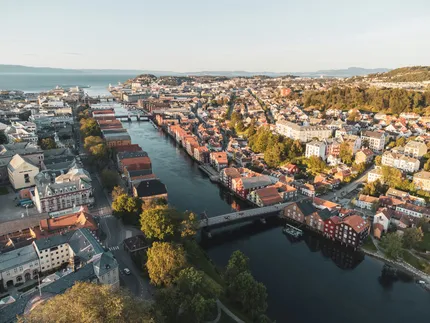
Best time to visit Trondheim
The best window for most travelers is late May through September, when daylight stretches, trails in Bymarka are snow‑free, and average highs sit around 15–22°C. June and August are lively with events such as Olavsfest and the Pstereo music festival, and outdoor cafés hum around Solsiden. Spring and early fall bring fewer crowds and good prices; September often adds crisp air and foliage along the Ladestien coastal path. Weather is changeable year‑round, so pack layers and a rain shell. Winter (December–March) is cold and dark but rewarding if you want cross‑country skiing, museum time, Christmas markets, and a quieter city.
More activities and things to see in Trondheim:
Kristiansten Fortress
Built after the 1681 city fire, Kristiansten Fortress guarded Trondheim from the east and offers superb panoramas of the city, fjord, and surrounding hills. Walk the ramparts, see cannons and casemates, and learn about its role during the Great Northern War and World War II. Popular picnic spot in summer.
Rockheim National Museum of Popular Music
Norway’s national museum of popular music traces the country’s sounds from the 1950s to today. Interactive exhibits let you sample tracks, remix, and try instruments. Highlights include the Touch Wall, temporary exhibitions, and a rooftop restaurant with fjord views. Engaging for all ages, with frequent concerts, talks, and workshops too.
Munkholmen Island
A short boat ride from the harbor takes you to Munkholmen, an island with layers of history as monastery, fortress, customs station, and prison. Join guided tours of the bastions and cells, relax on the small beach, or enjoy a cafe stop. Best in summer; ferries run regularly from May.
Sverresborg Trøndelag Folk Museum
Explore regional history at this hillside open‑air museum featuring more than 80 historic buildings relocated from around Trøndelag, including the medieval Haltdalen stave church. Period interiors, costumed interpreters, and craft demonstrations bring past lifeways alive. Family friendly, with farm animals in season, themed events, and sweeping views over Trondheim too.
Ringve Music Museum and Botanical Garden
Set in a historic manor, Ringve is Norway’s national museum of musical instruments, with engaging guided tours where hosts perform pieces on selected instruments. Collections span centuries and continents. Outside, the botanical garden showcases themed beds and regional plantings, with excellent fjord views. Combine culture and a peaceful stroll here.
Tyholttårnet (Tyholt Tower)
Ride the elevator up Tyholttårnet, a 124‑meter telecommunications tower with a revolving restaurant that completes a turn every hour. Enjoy panoramic views of Trondheim, Nidelva, and the fjord, especially at sunset. It’s an easy bus ride from the center, and casual meals make lingering with the scenery appealing for visitors.
Ladestien Coastal Trail
Follow this scenic coastal path along the Trondheim Fjord from Lade to Rotvoll. Expect beaches, viewpoints, WWII bunkers, picnic lawns, and birdlife. Stop at Ringve Bay or Korsvika for a swim on warm days, or grab coffee at cafes en route. Flat, well‑signed, and suitable for families and runners too.
Stiftsgården Royal Residence
Built in the 1770s, Stiftsgården is one of Scandinavia’s largest wooden palaces and serves as the Norwegian royal residence in Trondheim. Guided tours in summer reveal richly decorated rooms and stories of royal visits during national ceremonies at Nidaros Cathedral. Its central location makes it an easy cultural stop too.
Kayaking on the Nidelva River
See Trondheim from the water by kayaking on the calm Nidelva, passing colorful wharf warehouses, Bakklandet, and views of the cathedral spire. Outfitters offer rentals and guided trips suitable for beginners. Dress for weather, follow currents carefully, and enjoy a peaceful perspective on the city’s history and riverside architecture too.
Getting around in Trondheim
Trondheim’s compact center (Midtbyen, Bakklandet, Solsiden) is very walkable, with most sights within 10–20 minutes on foot. Cycling is popular in warmer months; there’s an expanding network of lanes, bike parking, and a public bike-share (Trondheim Bysykkel), plus e‑scooters. Hills can be steep, but the unique Trampe bicycle lift in Bakklandet helps, and studded tires make winter riding feasible. Public transport, run by AtB, is reliable: frequent metro-style bus lines crisscross the city and suburbs, complemented by the historic Gråkallbanen tram to Lian. Tickets and real-time info are in the AtB app; 24‑hour and 7‑day passes cover buses and tram. Night buses run on weekends. Taxis are easy to find but pricey; rideshare availability is limited. A car isn’t needed for central Trondheim and can be inconvenient due to tolls and scarce parking, but it helps for day trips around Trøndelag and fjord villages. In summer a small boat connects the harbor with Munkholmen; otherwise, walking and buses handle most local trips.
Getting to Trondheim
Fly into Trondheim Airport, Værnes (TRD), about 32 km east of the city in Stjørdal. It has frequent domestic flights to Oslo, Bergen, Stavanger, Tromsø, and Bodø, plus international routes to hubs like Copenhagen and Amsterdam, and seasonal services to London and other European cities. From the terminal, the regional train runs to Trondheim S in roughly 35–40 minutes; the Airport Express (Flybussen) and AtB buses also connect regularly. By rail, Trondheim is a major junction: the Dovrebanen links to Oslo (day and overnight trains), Nordlandsbanen continues north to Bodø (including a night train), and the Rørosbanen provides a scenic alternative toward Hamar/Oslo. For Sweden, regional trains via Storlien connect to Östersund and Sundsvall, offering onward links toward Stockholm. Long-distance buses such as Vy Express, Nor-Way Bussekspress, Lavprisekspressen, and FlixBus run to Oslo and other Norwegian cities, often overnight and at budget fares. The Hurtigruten/Havila coastal ships also call at Trondheim, useful for slow, scenic travel along Norway’s coast.
